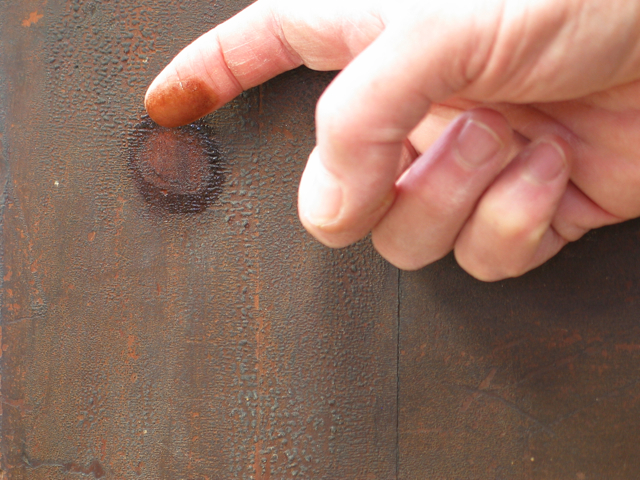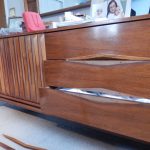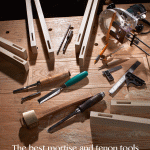We may receive a commission when you use our affiliate links. However, this does not impact our recommendations.
Editors note: Bob Flexner’s blog will move to the Flexner on Finishing Blog at the end of April. You can find it here.

Here I’m dabbing with denatured alcohol to determine that the finish is shellac.
A few years ago I was called to a long-time client’s house to look at a problem on their newly purchased eighteenth-century Chippendale dining set. I was excited. How often do I get to see something like this up close – that is, not in a museum?
But when I walked into the room, it was clear to me that something wasn’t right. The furniture didn’t look old. Moreover, there were eight identical dining chairs. How often do eight chairs survive for over 200 years?
But the couple, both of whom I liked a lot, were insistent. The antique dealer had seemed very trustworthy, and they had paid a lot for the furniture.
I needed some way to back up my suspicions. So I went out to the van and brought in several cans of solvents to do some tests. Because different finishes have been used at different times, it’s often possible to date furniture simply by the finish that was used on it.
In the 18th century and earlier, makers used whatever finish they had available, usually wax or linseed oil. If the maker lived near a port city, alcohol- or turpentine-soluble resins may have been available.
By the 1820s, transportation had improved and shellac flakes, along with other alcohol-soluble resins, became widely available. Alcohol evaporates rapidly so these finishes dry fast and don’t collect dust. As a result, shellac became the overwhelmingly dominant finish used on almost all furniture and woodwork for the next 100 years.
In the 1920s nitrocellulose lacquer became available and slowly replaced shellac as the favored finish. There were two primary reasons. First, shellac is a commodity product, so the higher the demand the higher the price. Second, in contrast to the single alcohol solvent required for shellac, lacquer thinner is a blend of many solvents with varying evaporation rates, so lacquer thinner can be adjusted (for example, by adding lacquer retarder or acetone) so the lacquer dries at a normal rate in widely varying weather conditions.
By the 1960s, a number of additional resins had been developed, which began replacing lacquer. These include primarily very durable catalyzed finishes. Later came polyester and UV-cured finishes. In the amateur market, polyurethane varnish slowly replaced alkyd varnish on furniture and shellac on floors.
In the 1980s and 90s, water-based finishes were introduced to address the growing demand for reduced VOCs in coatings.
With this historical knowledge, and assuming you’re dealing with an original (not refinished) finish, you can fairly accurately establish the period during which the furniture was made by testing with various solvents using a process of elimination.
- Wax dissolves in mineral spirits (paint thinner), naphtha and turpentine.
- Shellac dissolves in denatured alcohol.
- Lacquer dissolves in lacquer thinner.
- Water-based finish becomes soft and tacky in lacquer thinner, toluene and xylene.
Using one or more of these solvents, dab a little onto an inconspicuous area and see what happens. If nothing happens with any of these solvents, the finish is varnish or one of the newer more-solvent-resistant finishes.
I explained this history to my clients and started the testing on inconspicuous areas near the tabletop and on two of the chairs. Nothing “touched” the finish, not even acetone, which I also tried.
So we decided to turn the table over and look underneath, and there it was, the final proof: “Made in Korea.”
I hated to do this to my clients, but this was fraud. I volunteered to testify if they took the antique dealer to court. But, after a couple of days thinking it over, they decided they really liked the table and chairs, and they weren’t the suing type, anyway.
Here are some supplies and tools we find essential in our everyday work around the shop. We may receive a commission from sales referred by our links; however, we have carefully selected these products for their usefulness and quality.










My thought is that at the very least, they should try to get a partial refund to bring the cost in line with the quality of the reproduction.
Thanks for the concise and a clear explanation on determining the type of finish used and how this information can give you clues to the age of a piece.
I can appreciate your clients unwillingness to sue, however they are aiding and abetting this crooked dealer!